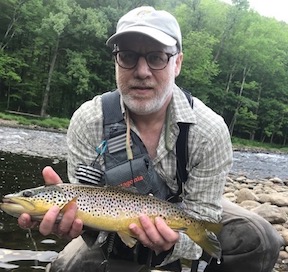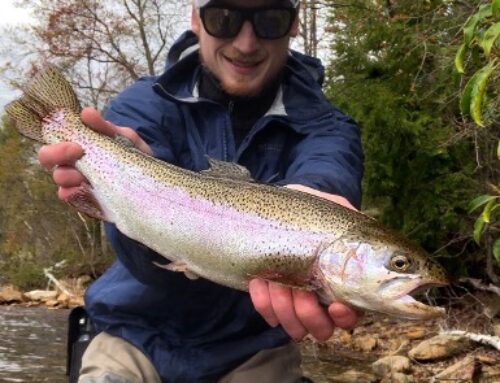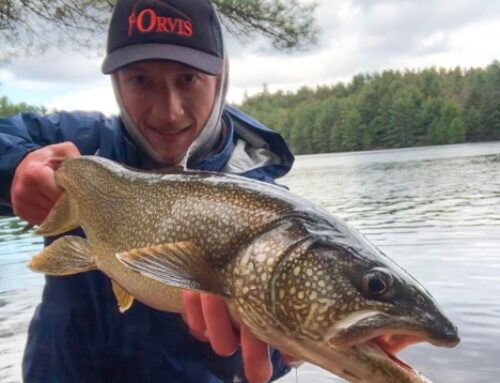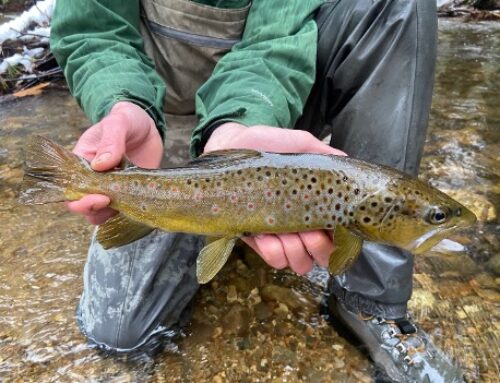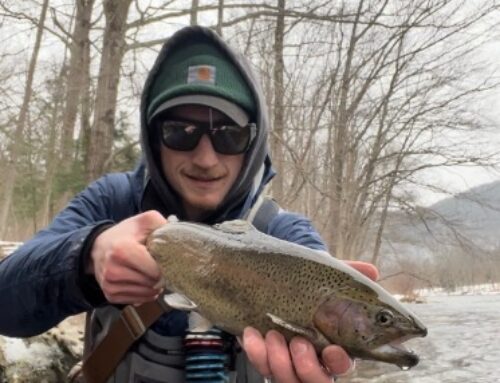Great dry fly action continues!
Please stop in and say hi. We are open from noon to 5, Tuesday through Sunday. I am often here at other hours so call us at 413-397-3665 if you need something at times outside of our posted hours. Also, we are still more than happy to do curbside service if you prefer. Just give us a call or email brian@deerfieldflyshop.com.
Always wanted to try Euro-style nymph fishing? We received a handful of demo nymphing rods from Echo. Mike and I field tested them yesterday and are happy to report they work! We have Echo’s top end Shadow X in a 10’6″ 3 weight and their mid-range Shadow II in a 10′ 2 weight and 10’6″ four weights. We will loan these rods out if you are interested in giving tight line nymphing a go. Come into the shop to check them out!
The Deerfield River is fishing well, though we could use some more water in the system. With this week’s increase in temperatures coming, and no rain in the immediate forecast, fishing will continue to be best in the early mornings and late evenings. Releases have been short and infrequent. I recommend seeking out this bigger water when you can–just use extra caution if you are wading. The good news is you do not have to wade out far as the fish will often push to the sides when the water comes up.
The sulphur hatch can be very productive in the late evening, often just before or at dark. Sparkle duns in 14 to 18 and spinners in 14 and 16 are working well. Caddis in tan and olive in a size 14 still abound, and we are seeing more and more Yellow Sallies in 12 to 16. Some bigger stones are also around. Light Cahills in size 12 to 14 are still very much on the menu and I suspect that we will be seeing more and more Cream Cahills–you can use any Light Cahill pattern for these, just go down to 14s and 16s. Spinners have become more important so make sure you have a good collection of rusty spinners from 12 to 18 and some lighter colored spinners in 14 and 16. We have a good selection in stock right now including some shop tied spinners specifically for the sulphurs that have been successfully field tested since the hatch began! March Browns are still around as well as BWOs on cloudy cooler days.

The trout can get very fussy on dry flies, especially in low water. Sometimes you need to change your presentation angle–try a downstream presentation to difficult fish–just be sure to throw in a reach mend or wiggle mend on the cast to get a nice drag free drift. You can also try lengthening your leader. I fish mostly 12 foot leaders to 4X or 5X with an additional two feet of tippet. Going down to 6X and 7x on the tippet is also sometimes necessary.
Water temps in the lower river are starting to get too high for catch and release trout fishing except in the very early morning and at dark. The smallmouth fishing is really turning on though, with smaller streamers and crawfish patterns fooling nice smallies. Try topwater sliders and poppers in the mornings and evenings and fish the deeper holes with good cover during the day. The Connecticut River also has some great smallmouth fishing and access points in Turners Falls are always a good bet. The carp fishing can be great, particularly on the flats in the Connecticut, but the shop’s resident warmwater guru Reece cautions that some are on are on the spawn and spawning carp rarely take a fly.
In the upper river, water temperatures are still great for trout. When the trout are not rising, nymphs continue to work, especially pheasant tails in sizes 12-14, hare’s ears in the same sizes, bigger stoneflies like Pat’s Rubber Legs and Buggy Stones, and caddis larvae and pupae in size 14, both in olive and tan. Working some smaller size 16 nymphs that imitate sulfurs (smaller copper johns and pheasant tails will work) is a good idea. Also, we are seeing a lot of craneflies and other big bugs like that so mop flies as well as crane fly and damselfly nymhs will be effective as well. At low water, smaller streamers like wolly buggers and small sculpins will work. In the bigger water during the release you can try throwing bigger streamers including articulated ones like Headbangers and D and Ds, especially in the early mornings and late evenings.
The trout are used to looking up for a meal now so prospecting with attractors and terrestrials is a good idea, even more so when a nymph is dropped off the back. My go to rig for this on area rivers, from mid-May to October, is a big humpy in 10 or 12 with a size 12 pheasant tail dropped off the bend of the hook. Royal Wulffs, Stimulators, big caddis–basically any bushy dry fly will work and for terrestrials ants and beetles are always a good bet along with smaller Chubby Chernobyls.

The Millers River is getting lower and warmer. I would recommend only fishing here in the early mornings and late evenings or on cloudy, colder days. That said, the fishing can still be good with caddis, sulphurs and cahills still hatching strong. Terrestrials are good as well. The smallmouth fishing, particularly on the lower part of the river, is fantastic. The same tactics and flies mentioned above for the lower Deerfield apply here.
The Westfield is quite low. I think the sweet spot here is 100 to 500 cfs and we are in the 60s. If you intend to release fish, I would fish somewhere else. But if you must, fish early mornings and late evenings. If we ever get a decent push of rain, this river will come back into play.
The Swift River is always cold and is actually running higher than average as its release from the Quabbin dam is tied to the levels on the Connecticut–when this is low, more water is released into the Swift to augment flows, or so I’ve been told. Reports say the sulphur hatch on the Swift is on fire right now, which gives anglers an opportunity to put away the tiny 28s and 30s and throw huge, by Swift standards, 16 and 18 sulphurs! Ants and beetles are also a good bet on the Swift this time of year.
Guided trips and lessons available. Call us at 413-397-3665 or email brian@deerfieldflyshop.com.
Dries: Midges, tan and olive Caddis 14-16, BWO 16-20, Light Cahill 12-14, March Brown 12-14, Sulphurs 14-16, Humpies 10-12, Royal Wulffs 10-12, Stimulators 10-16, Yellow sallies 14-16, beetles, and ants.
Nymphs: Pat’s Rubber Legs, Golden or Black Terminator Stone 8-12, hares’ ears 12-18, Pheasant Tail Nymphs 12-18, Frenchies 12-16, Tan/Olive Mops, damselfly nymphs, Natural/Olive Caddis Puppa/Larvae 12-16, Red/Copper Johns 12-16, Sexy Walt 12-16.
Streamers: Woolly Buggers Olive/Black 6-10, White/Olive Sculpzilla 8,Bank Robber 2, Mini Headbangers, Complex Twist Bugger, Heisenberg Baby Bow/Cowboy/White 6, Sculpin Bunny, Black/Brown Rubber Bugger 4, Olive and Gold/White Mini Drunk & Disorderly.
Water Flows for Fife Brook Dam can be found here
Water release schedule for the next day is posted after 5pm. Check again before you head to the river. Minimum Flow 130 CFS (Cubic Feet/Second). Ideal for wading and Dry Fly Action. Normal Release 800-1,000 CFS
For Miller’s River in Erving here
For Miller’s River Bear’s Den area here
For East Branch of the Westfield here


